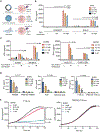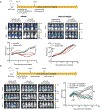Targeting a neoantigen derived from a common TP53 mutation
- PMID: 33649166
- PMCID: PMC8208645
- DOI: 10.1126/science.abc8697
Targeting a neoantigen derived from a common TP53 mutation
Abstract
TP53 (tumor protein p53) is the most commonly mutated cancer driver gene, but drugs that target mutant tumor suppressor genes, such as TP53, are not yet available. Here, we describe the identification of an antibody highly specific to the most common TP53 mutation (R175H, in which arginine at position 175 is replaced with histidine) in complex with a common human leukocyte antigen-A (HLA-A) allele on the cell surface. We describe the structural basis of this specificity and its conversion into an immunotherapeutic agent: a bispecific single-chain diabody. Despite the extremely low p53 peptide-HLA complex density on the cancer cell surface, the bispecific antibody effectively activated T cells to lyse cancer cells that presented the neoantigen in vitro and in mice. This approach could in theory be used to target cancers containing mutations that are difficult to target in conventional ways.
Copyright © 2021 The Authors, some rights reserved; exclusive licensee American Association for the Advancement of Science. No claim to original U.S. Government Works.
Conflict of interest statement
Figures






Comment in
-
Targeting cancer with bispecific antibodies.Science. 2021 Mar 5;371(6533):996-997. doi: 10.1126/science.abg5568. Epub 2021 Mar 1. Science. 2021. PMID: 33649167 No abstract available.
-
Bispecific antibodies catch cancer neoantigens.Nat Rev Drug Discov. 2021 May;20(5):342. doi: 10.1038/d41573-021-00062-2. Nat Rev Drug Discov. 2021. PMID: 33785902 No abstract available.
-
Bispecifics target cancers' most wanted.Nat Rev Cancer. 2021 May;21(5):279. doi: 10.1038/s41568-021-00354-0. Nat Rev Cancer. 2021. PMID: 33790461 No abstract available.
-
Arming "old guards" with "new dual-targeting weapons".Cancer Cell. 2021 May 10;39(5):604-606. doi: 10.1016/j.ccell.2021.04.010. Cancer Cell. 2021. PMID: 33974858
-
The arsenal of TP53 mutants therapies: neoantigens and bispecific antibodies.Signal Transduct Target Ther. 2021 Jun 3;6(1):219. doi: 10.1038/s41392-021-00635-y. Signal Transduct Target Ther. 2021. PMID: 34083505 Free PMC article. No abstract available.
-
Neoantigens take center stage.Nat Cancer. 2021 Dec;2(12):1288. doi: 10.1038/s43018-021-00310-9. Nat Cancer. 2021. PMID: 35121912 No abstract available.
References
Publication types
MeSH terms
Substances
Grants and funding
LinkOut - more resources
Full Text Sources
Other Literature Sources
Medical
Molecular Biology Databases
Research Materials
Miscellaneous

